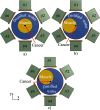Design of multi-modal antenna arrays for microwave hyperthermia and 1H/1⁹F MRI monitoring of drug release
- PMID: 39446902
- PMCID: PMC11501028
- DOI: 10.1371/journal.pone.0312343
Design of multi-modal antenna arrays for microwave hyperthermia and 1H/1⁹F MRI monitoring of drug release
Abstract
This simulation-based study presented a novel hybrid RF antenna array designed for neck cancer treatment within a 7T MRI system. The proposed design aimed to provide microwave hyperthermia to release 19F-labeled anticancer drugs from thermosensitive liposomes, facilitating drug concentration monitoring through 19F imaging and enabling 1H anatomical imaging and MR thermometry for temperature control. The design featured a bidirectional microstrip for generating the magnetic |B1|-fields required for 1H and 19F MR imaging, along with a patch antenna for localized RF heating. The bidirectional microstrip was operated at 300 MHz and 280 MHz through the placement of excitation ports at the ends of the antenna and an asymmetric structure along the antenna. Additionally, a patch antenna was positioned at the center. Based on this setup, an array of six antennas was designed. Simulation results using a tissue-mimicking simulation model confirmed the intensity and uniformity of |B1|-fields for both 19F and 1H nuclei, demonstrating the suitability of the design for clinical imaging. RF heating from the patch antennas was effectively localized at the center of the cancer model. In simulations with a human model, average |B1|-fields were 0.21 μT for 19F and 0.12 μT for 1H, with normalized-absolute-average-deviation values of 81.75% and 87.74%, respectively. Hyperthermia treatment was applied at 120 W for 600 s, achieving an average temperature of 40.22°C in the cancer model with a perfusion rate of 1 ml/min/kg. This study demonstrated the potential of a hybrid antenna array for integrating 1H MR, 19F drug monitoring, and hyperthermia.
Copyright: © 2024 Hernandez et al. This is an open access article distributed under the terms of the Creative Commons Attribution License, which permits unrestricted use, distribution, and reproduction in any medium, provided the original author and source are credited.
Conflict of interest statement
The authors have declared that no competing interests exist.
Figures












Similar articles
-
A printed Yagi-Uda antenna for application in magnetic resonance thermometry guided microwave hyperthermia applicators.Phys Med Biol. 2017 Mar 7;62(5):1831-1847. doi: 10.1088/1361-6560/aa56b3. Epub 2017 Jan 4. Phys Med Biol. 2017. PMID: 28052042
-
Simulation-based design and characterization of a microwave applicator for MR-guided hyperthermia experimental studies in small animals.Biomed Phys Eng Express. 2020 Jan;6(1):015001. doi: 10.1088/2057-1976/ab36dd. Epub 2019 Nov 27. Biomed Phys Eng Express. 2020. PMID: 32999735 Free PMC article.
-
Design and characterisation of miniaturised cavity-backed patch antenna for microwave hyperthermia.Int J Hyperthermia. 2015;31(7):737-48. doi: 10.3109/02656736.2015.1068957. Epub 2015 Sep 12. Int J Hyperthermia. 2015. PMID: 26365603
-
Recent technological advancements in radiofrequency- andmicrowave-mediated hyperthermia for enhancing drug delivery.Adv Drug Deliv Rev. 2020;163-164:3-18. doi: 10.1016/j.addr.2020.03.004. Epub 2020 Mar 27. Adv Drug Deliv Rev. 2020. PMID: 32229271
-
Cardiac tissue ablation with catheter-based microwave heating.Int J Hyperthermia. 2004 Nov;20(7):769-80. doi: 10.1080/02656730412331286885. Int J Hyperthermia. 2004. PMID: 15675671 Review.
Cited by
-
Effect of the Compartmentalization Into Liposome's Cavity on the Relaxation Times of F- and PF6 - Anions.NMR Biomed. 2025 Aug;38(8):e70084. doi: 10.1002/nbm.70084. NMR Biomed. 2025. PMID: 40538071 Free PMC article.
References
MeSH terms
Substances
LinkOut - more resources
Full Text Sources
Medical

